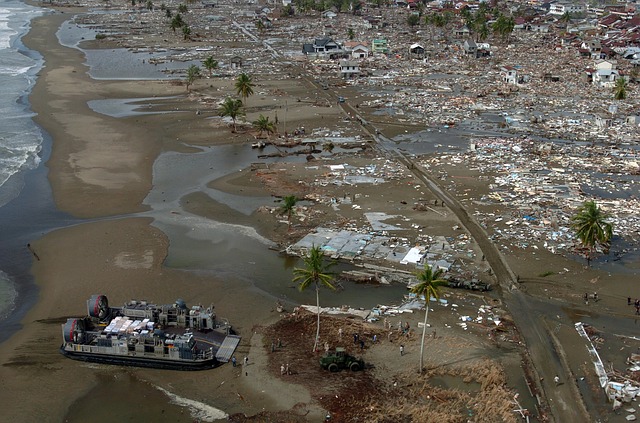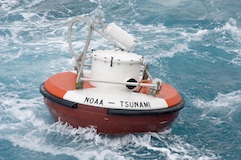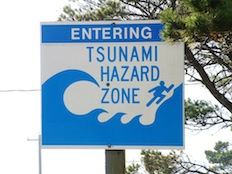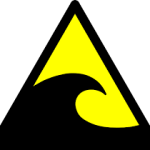
Tsunamis (pronounced soo-ná-mees), also known as seismic sea waves (mistakenly called “tidal waves”), are a series of enormous waves created by an underwater disturbance such as an earthquake, landslide, volcanic eruption, or meteorite. A tsunami can move hundreds of miles per hour in the open ocean and smash into land with waves as high as 100 feet or more.
From the area where the tsunami originates, waves travel outward in all directions. Once the wave approaches the shore, it builds in height. The topography of the coastline and the ocean floor will influence the size of the wave. There may be more than one wave and the succeeding one may be larger than the one before. That is why a small tsunami at one beach can be a giant wave a few miles away.
All tsunamis are potentially dangerous, even though they may not damage every coastline they strike.
A tsunami can strike anywhere along most of the U.S. coastline.
The most destructive tsunamis have occurred along the coasts of California, Oregon, Washington, Alaska and Hawaii.
Earthquake-induced movement of the ocean floor most often generates tsunamis. If a major earthquake or landslide occurs close to shore, the first wave in a series could reach the beach in a few minutes, even before a warning is issued. Areas are at greater risk if they are less than 25 feet above sea level and within a mile of the shoreline. Drowning is the most common cause of death associated with a tsunami. Tsunami waves and the receding water are very destructive to structures in the run-up zone. Other hazards include flooding, contamination of drinking water, and fires from gas lines or ruptured tanks.
What is a tsunami and where do they happen?
A tsunami is a series of large ocean waves usually caused by a major earthquake on the sea floor, a landslide, or volcanic activity. Tsunamis are not affected by tides or currents; a tsunami in the ocean means the whole water column is moving, not just the surface. A tsunami can strike any ocean shoreline.
When tsunami waves enter shallow water, they rise to form massive moving water called “runup.” Runup, which can be many feet high, then rushes onto shore, striking the coast with tremendous, destructive force.
If you are on the shore and in a low coastal area, you should know that a tsunami could arrive within minutes after the earth shakes. A devastating tsunami can also happen when a major earthquake happens far away. Recent earthquakes in Chile and Japan have caused tsunami strikes in Hawaii, Alaska, Washington, Oregon, and California, causing loss of life and millions of dollars in property damage.
The tsunami danger period can continue for many hours as the waters move onto land, recede, and return. Sometimes, the second or third waves are more devastating than the first. A tsunami can occur during any season of the year and at any time, day or night.
What is the best source of information in a tsunami situation?

Listen to local news reports and visit the NOAA/National Weather Service website,tsunami.gov.
The International Tsunami Warning System monitors oceans through a network of buoys and scientific instruments. When the instruments detect a major earthquake and the potential for a tsunami to occur, warnings are issued to local authorities who can order the evacuation of low-lying areas, if necessary.
The National Oceanic and Atmospheric Administration’s (NOAA) National Weather Service operates two tsunami warning centers:
- The National Tsunami Warning Center (NTWC) in Palmer, Alaska, serves all U.S. states except Hawaii. It also serves Puerto Rico, the Virgin Islands, and Canada.
- The Pacific Tsunami Warning Center (PTWC) in Honolulu, Hawaii, serves Hawaii and the U.S. Pacific territories. It also serves as the primary international warning center for the Pacific Ocean and the Caribbean and South China Seas.
What are the warning signs of a tsunami?
- A strong earthquake, felt in a coastal area, that causes difficulty standing
- A noticeable rapid rise or fall in coastal waters
- A loud roaring sound coming from the ocean
How can I prepare for a tsunami ahead of time?
Find out if your home, school, workplace, or other frequently visited places are in a tsunami hazard area or evacuation zone. If they are:
- Know their height above sea level and their distance from the coast and other high-risk waters. Evacuations may be based on these numbers.
- Plan evacuation routes to safe locations from these places. If possible, pick locations 100 feet (30 meters) above sea level or as far as 2 miles (3 kilometers) inland, away from the coast. If you cannot get this high or far, go as high or far as you can. Every foot inland or upward may make a difference. An alternative in some areas is “vertical evacuation,” which means going to a high floor of a tall building.
- Find out what your school’s evacuation plan is. Schools will keep children safe by moving them out of harm’s way. Find out where the assembly area is and where you should pick up your children. Do not rush to the school during an evacuation.
- Put together a family emergency plan and a portable disaster supplies kit that is easily accessible and contains basic items you and your family may need in an emergency.
- Practice walking evacuation routes. Familiarity may save your life. Be able to follow your escape route at night and during inclement weather. Practicing your plan will make it easier to understand and to do during an actual emergency.
If you are a coastal visitor, find out about local tsunami safety procedures. For long lead-time warnings, you may be asked to leave by driving away. For short lead-time warnings, you may be able to take refuge in reinforced concrete hotel structures on the third floor or above.
What should I do when a tsunami may happen?
If you are in a coastal area and feel a strong earthquake:
- Drop, cover, and hold on. You should first protect yourself from the earthquake.
- When the shaking stops, move quickly to higher ground away from the coast. A tsunami may be coming within minutes.
- Be prepared for aftershocks, which happen frequently after earthquakes. Each time the earth shakes, drop, cover, and hold on.
- Move to your designated safe location or as far inland and uphill as possible.
During a tsunami watch:
- Locate loved-ones and review evacuation plans. Be ready to move quickly if a tsunami warning is issued.
During a tsunami advisory:
- Because of the threat of a potential tsunami that may produce strong currents or waves dangerous to those in or near the water, local officials may close beaches, evacuate harbors and marinas, and ask ships to reposition to deep water. Obey their directions.
During a tsunami warning:
- If you hear a tsunami warning siren, detect signs of a tsunami, or hear about a tsunami warning on the radio or TV, leave immediately.
- Ask neighbors who may need help leaving to come with you and offer assistance.
- Bring pets with you to keep them safe.
- Take your disaster supplies kit. Having supplies will make you more comfortable.
- Move to higher ground as far inland as possible. Watching a tsunami near the shore is dangerous, and it is against the law to remain in an evacuated area.
- Keep listening to NOAA Weather Radio All Hazards or local radio or TV for the latest updates.
Source: FEMA, NOAA, NTHMP


